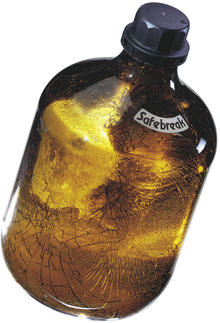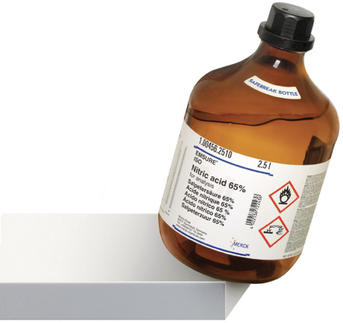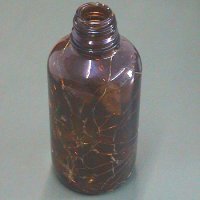Hi Charlotte and Woofy
Other link of Safebreak Protected Bottles:
Creaco Safebreak® Protected Bottles
www.creaco.co.uk/bottles.htm
Why protect bottles?
Glass is the preferred medium for the packaging of liquid chemicals. It is basically inert, transparent and has good surface quality allowing for easy cleaning. It's disadvantage is the vulnerability to breakage.
If a bottle of dangerous chemicals is dropped (mineral acids, strong alkali etc) the results can range from widespread contamination of glass and chemical contents in sensitive areas, to a worse case scenario of serious injury to laboratory personnel, especially given the hazardous nature of some of the chemicals used, or other traumatic consequences.
Creaco primarily developed Safebreak® protected bottles for the chemical industry, for safety in such places as laboratories.
Creaco Safebreak® Protected bottles provide the solution.
The Creaco Safebreak® protected bottle provides a solution to this problem. The protective coating on the bottle will contain all the glass and hazardous chemicals in case of an accident, minimising risk and contamination, and making clearing up the hazard much easier.
The protective surlyn® coating on the bottle has a good resistance to most solvents and only the most aggressive acids can affect it after a significant period of exposure. This means that the bottles contents, even if hazardous, will be contained within the protective 'skin' in the event of an accident. In addition it has a high tear strength and exceptional clarity. The coating has the added advantage of raising the breakage threshold of the glass container making it safer in transit.
Creaco supply Safebreak® bottles to the chemical industry ranging in size from 10ml to 4000ml. We have supplied the coating service to major chemical companies in the UK and Europe for over twenty years and are acknowledged throughout this field.
Creaco protects a wide range of bottles
Creaco Safebreak® protected bottles are not just limited to the chemical industry. Cosmetic companies are supplying and developing new products in glass aerosol bottles. The propellant (containing no CFC's) operates at a high pressure and could previously only be supplied in tin plate containers. Glass is the preferred medium for many cosmetics as it's aesthetic properties together with it's weight and clarity convey the impression of purity and quality of product. A disadvantage of glass is that it can break, and if the container is pressurised, the consequences of breakage can be serious.
Creaco Ltd have a solution to this problem. A thick covering of DuPont Surlyn®, a tough absolutely transparent plastic with a high tear strength is applied to the glass. The plastic coating faithfully follows the contours of the bottle, completely covering any difficult shapes. Should the aerosol be broken all the glass fragments and normally all the contents are contained. In extreme cases a small seepage of product may occur but there is no danger of flying glass. The coating is environmentally friendly and contains no ozone depleting chlorine or fluorine compounds. It also meets all food and drug industry standards and passes all appropriate flammability tests.
Creaco Ltd can also apply coloured coatings, either transparent, translucent or solid colour and metallic or pearlescent effects to glass, giving exciting marketing potential. In addition the coating readily accepts a wide range of labeling methods. Creaco offer a protection service for your custom aerosol bottles.





